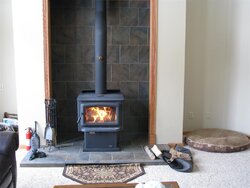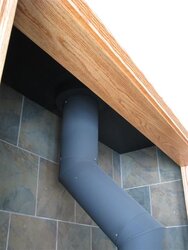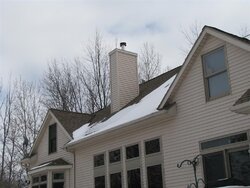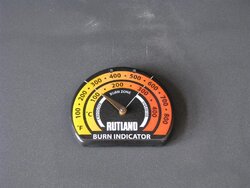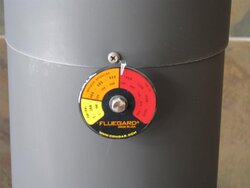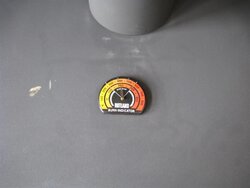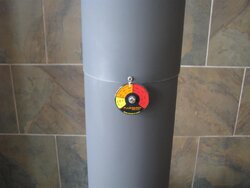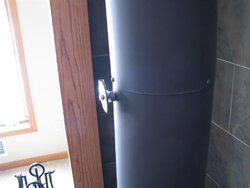I was reading a thread started by Oldspark regarding the inability to achieve the stove top temps he would like with his Summit. I started burning my PE Summit on 12/19/12, and it's been going ever since 24/7. I've had a Lopi and a Quadrafire in the past and have had no problem getting those stoves to 800-900 degrees if I wasn't careful. That wasn't ever my goal, but a fresh load unattended for a little to long would do it. Fast forward to a new house and new stove, PE Summit. Had it installed where our zero clearance used to be. It has about 7' of ICC Ultra Black with (2) 45's in it, and that takes me to the top of the alcove its in. From there it connects to 20ft of Excel stainless double wall. I'm burning Ash that's been dead for years, but CSS last spring/summer. My stove burns great, awesome secondaries and good heat. But there are days when I need it to run hotter, or it has trouble keeping up. I installed a flue gas temp probe (Condar) which I know reads a little hot, but it still seems too hot. When starting a new load, my flue gas temp will run to 1200 degrees when the stove top is only 350. As I type this the stove has settled in with a nice burn, air control on low, stove top 450, flue temp 900. Any thoughts. Thanks. SB
Getting more heat out of my Summit
- Thread starter Sodbuster
- Start date
-
Active since 1995, Hearth.com is THE place on the internet for free information and advice about wood stoves, pellet stoves and other energy saving equipment.
We strive to provide opinions, articles, discussions and history related to Hearth Products and in a more general sense, energy issues.
We promote the EFFICIENT, RESPONSIBLE, CLEAN and SAFE use of all fuels, whether renewable or fossil.
You are using an out of date browser. It may not display this or other websites correctly.
You should upgrade or use an alternative browser.
You should upgrade or use an alternative browser.
- Status
- Not open for further replies.
That does sound hot in the flue even if the the Condar probe is off by a couple hundred degrees.Is this the old style EBT (on front boost manifold) or the new style (in back on secondary intake)?
It should be the new style, but it could be an older stove. If you pull the ash pan out, the old EBT is a 1" tall by about 3"x5" box in the front center, underbelly of the stove. If it is the new style it is in the back center underbelly of the stove.
To correct the high temps of your pipe you will need to dial back on the primary air sooner.
Am I assuming correctly that this is an insert??
Am I assuming correctly that this is an insert??
With the high stack temp and the low stove temp - you may also want to consider a key damper for your pipe. Keep that heat in the stove by slowing down the air flow.
At what stove top temp do you typically close the air control all the way? You can start closing it down as soon as the wood is involved in flame and secondary burning starts. Close it down in 50% increments with maybe 5 minutes in between each step. Close it down until the flames start getting lazy, but not snuffing out the fire entirely.
As a separate test entirely: Do you have a refrig magnet or flat magnet about 1" sq? If so, try placing that magnet over the small hole at the front bottom center and see how it affects the burn. This is the air entry for the boost manifold.
As a separate test entirely: Do you have a refrig magnet or flat magnet about 1" sq? If so, try placing that magnet over the small hole at the front bottom center and see how it affects the burn. This is the air entry for the boost manifold.
madison
Minister of Fire
Sod,
Quoting from initial post: ..." My stove burns great, awesome secondaries and good heat. But there are days when I need it to run hotter, or it has trouble keeping up."
Where do you live? And size/type of house. If you are attempting to heat an average insulated 3000 sq ft house in - 20 degree temps entirely with wood, the average stove will not "keep up".
And is the summit an insert (as in your avatar?) or freestanding in an alcove? Blower?
But if you are looking for troubleshooting advice:
First thing I would look for is a leak - ash chute door would be the first culprit, EBT and door fit as well. Since you have "great burns" and high chimney temps, I would look for air leaks into the fire chamber. How long do these "great burns" last, if < 6 hrs, look for a leak!
Could you add a couple pictures of your setup, specifically, thermometers - locations etc. I assume you have tried swapping the thermometers to rule out temp reading errors?
Quoting from initial post: ..." My stove burns great, awesome secondaries and good heat. But there are days when I need it to run hotter, or it has trouble keeping up."
Where do you live? And size/type of house. If you are attempting to heat an average insulated 3000 sq ft house in - 20 degree temps entirely with wood, the average stove will not "keep up".
And is the summit an insert (as in your avatar?) or freestanding in an alcove? Blower?
But if you are looking for troubleshooting advice:
First thing I would look for is a leak - ash chute door would be the first culprit, EBT and door fit as well. Since you have "great burns" and high chimney temps, I would look for air leaks into the fire chamber. How long do these "great burns" last, if < 6 hrs, look for a leak!
Could you add a couple pictures of your setup, specifically, thermometers - locations etc. I assume you have tried swapping the thermometers to rule out temp reading errors?
Begreen, I usually start to shut my stove down when the top reaches around 300 or so. Much sooner and I lose secondaries. I also do it in stages rather than just slam the air closed. First, I close the control until I can see a change in the flame, usually about halfway, maybe a little more. Then I let the shut it down the rest of the way over about 20 minutes. Madison, my avatar is my old stove from another house, it's a Lopi Liberty insert. My new stove is a free standing Summit w/blower in an alcove, I'll post a couple pics with the chimney set up. Our house is around 2800 square feet and well insulated with 2x6 walls and R60 in the attic. I notice that I start to need a hotter stove when the temp drops into the low teens to single digits. I live in Michigan, so no -20 here thank God. I plan on checking for air leaks as soon as the weather warms up a bit.
madison
Minister of Fire
sod,
3300 sq ft here with 6" stick walls. But a ton of glass, cathedral ceilings and sliding glass doors (6). ~>= 20's no problem heating 90% with wood.
the high stack temps you have are weird, imho, i would look at the ash chute, especially if you are using it, it leaks.
3300 sq ft here with 6" stick walls. But a ton of glass, cathedral ceilings and sliding glass doors (6). ~>= 20's no problem heating 90% with wood.
the high stack temps you have are weird, imho, i would look at the ash chute, especially if you are using it, it leaks.
So I did the dollar bill test, and I could pull the bill from the handle side, and the bottom quite easily. How tightly should it fit? The gasket was also a different color where the bill came out the easiest, as was the metal that holds the window in. Indication of air leak?
Hogwildz
Minister of Fire
Blackening in the area would indicate a leak. If you can wiggle the dollar bill side to side, then it needs adjustment. If the bill is snug, yet does not easily wiggle, then your good to go.
madison
Minister of Fire
Tom (chimneysweeponline.com) posted a while back that the high density graphite gaskets on the PE's do not have to be overly tight, just as long as the bill does not fall out if I recall.
If you see a white hot area or blowtorch like area around the ash chute, that would be where I would concentrate my search.
If you see a white hot area or blowtorch like area around the ash chute, that would be where I would concentrate my search.
certified106
Minister of Fire
Quick question for you: do you have the fan on when you are getting the stove going again? If my fan is on the stove top temps will lag big time!
On my T6 I don't care at all what my stove top temp is I start and get my stove restarted completely off of looks and flue temps. I never allow my flue temps to get above 600 on a startup while maintaining a good flame/secondary combustion. Most of the time once it has settled in with my fan on low to medium my flue temps will be around 500 on a probe and my stove top will be around 550. If I turn the fans off the stove top will creep up to 750ish. If you have the fan on all bets are off on what your stove top will be as mine seems to lower the temp by around 150-250 degrees.
I know some people may not like my method of starting the stove back up but it works perfect for me and my wife is able to run the stove like a champ using this method. If it is warmer outside i will shut it down and keep almost no flame in the box but a nice small secondary combustion going to keep the amount of wood burning to a smaller amount.
On my T6 I don't care at all what my stove top temp is I start and get my stove restarted completely off of looks and flue temps. I never allow my flue temps to get above 600 on a startup while maintaining a good flame/secondary combustion. Most of the time once it has settled in with my fan on low to medium my flue temps will be around 500 on a probe and my stove top will be around 550. If I turn the fans off the stove top will creep up to 750ish. If you have the fan on all bets are off on what your stove top will be as mine seems to lower the temp by around 150-250 degrees.
I know some people may not like my method of starting the stove back up but it works perfect for me and my wife is able to run the stove like a champ using this method. If it is warmer outside i will shut it down and keep almost no flame in the box but a nice small secondary combustion going to keep the amount of wood burning to a smaller amount.
Based on that info guys I think my stove gasket is fine. I can pull the bill out but only with a fairly strong pull. Definitely doesn't wiggle or fall out. No ash pan, and the gasket looks fine from underneath. Certified, I started turning off my blower when restarting and that does work much better, as far as run away flue temps. I could never keep my flue temps below 600 however, once the secondaries are firing and the air is shut completely down, the flue temps are almost always double my stove top. Last night for example stove was at 450 and flue was at 1000. This was after an hour of low burn.
What does the fire look like on a "low burn" in the stove? Can you post some pictures of the installation that include the piping setup?
The fire "looks" like I could stand to shut it down a bit more. It is lazy, but the flames still lick around the baffle and up towards the chimney at a pretty good clip. Here are some pics of my set up.
Attachments
Nice setup. In that picture it looks like the air control is close to wide open. That is going to produce high flue temps and low stove top temps.
Does the flue thermometer's needle get hung on the screw head behind it sometimes?
Does the flue thermometer's needle get hung on the screw head behind it sometimes?
Yes it is wide open, that was a fresh load, its been burning for about an hour now. The pic is deceiving, that screw is about an inch away from the thermo. Here are a couple more with the air completely shut down The flue temp is almost always double the stove top on low burn, until I reach the coaling stage.
Attachments
That's better, but I would expect the stove top to be closer to 550-600F with that sized load. Try turning down the air sooner. When you have a burn going like that the air should be down to about 1/2 or 1/4. One thing you can do is pack it tighter so that there is less air between the splits. Next season try splitting up a lot of wood twice as thick. Big splits = longer burns.
certified106
Minister of Fire
Based on that info guys I think my stove gasket is fine. I can pull the bill out but only with a fairly strong pull. Definitely doesn't wiggle or fall out. No ash pan, and the gasket looks fine from underneath. Certified, I started turning off my blower when restarting and that does work much better, as far as run away flue temps. I could never keep my flue temps below 600 however, once the secondaries are firing and the air is shut completely down, the flue temps are almost always double my stove top. Last night for example stove was at 450 and flue was at 1000. This was after an hour of low burn.
Yeah those flue temps seem a little high compared to what I am used to...... Right now mine is packed full with the air all the way shut down and has been running for about an hour and my flue temps are 500 degrees with almost no visible flames on the wood and the secondary combustion burning good. Bergen may be on to something regarding the split size.... It tend to feed my stove large to medium pieces of wood and filling the gaps with small pieces. I would also agree that you should try to pack it as tight as possible however that being said I still thing 1000 degree flue temps is to high and it seems as if something else is going on.
I would still highly encourage you to work on shutting the air down sooner to keep those flue temps from getting that high. How dry is your wood? If your wood isn't dry enough that can also cause you to have to run the primary air open for much longer before you can sustain a good secondary combustion.
How did you test the wood? Split the rounds in half at least. They will dry better.
Love the avatar. Is that your pup?
Love the avatar. Is that your pup?
- Status
- Not open for further replies.
Similar threads
- Replies
- 9
- Views
- 1K
- Replies
- 4
- Views
- 917
- Replies
- 2
- Views
- 792
- Replies
- 8
- Views
- 626


